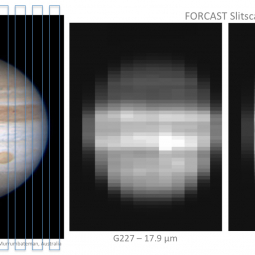For the first time since the twin Voyager spacecraft missions in 1979, scientists have produced far-infrared maps of Jupiter using NASA’s Stratospheric Observatory for Infrared Astronomy, SOFIA. These maps were created from the researchers’ studies of the circulation of gases within the gas giant planet’s atmosphere.
Far-Infrared observations provide details not possible at other wavelengths. When gas planets like Jupiter are studied with visible light, they can only see the light reflecting from the top of the gas clouds that make up the atmosphere. Using infrared light allows scientists to see past the clouds and into the deep layers of the atmosphere, providing a three-dimensional view of the planet and the ability to study how gasses circulate within the atmosphere.
Leigh N. Fletcher from the University of Leicester, England, led a team of researchers that used the SOFIA telescope and data from the Faint Object infraRed Camera for the SOFIA Telescope, known as FORCAST, to make these observations. Fletcher’s team was looking for the two types of molecular hydrogen, called “para” and “ortho” – differentiated by whether their protons have aligned or opposite spins. The fraction of hydrogen in the “para” flavor is a good indicator for gasses upwelling from deep within the planet’s atmosphere. These two different flavors of hydrogen were observed at infrared wavelengths between 17 and 37 microns, a spectral range that is largely inaccessible to ground-based telescopes.
Much of the current understanding of Jupiter’s circulation patterns are based on results from space-based missions of the past, including the Voyager mission , Galileo mission (1989–2003), and the Cassini spacecraft , which flew past Jupiter in 2000. SOFIA’s airborne location, above more than 99 percent of Earth’s infrared-blocking water vapor, combined with the powerful FORCAST instrument, provides one of the only current facilities capable of studying Jupiter’s overall atmospheric circulation. These new SOFIA observations allow comparisons of how Jupiter’s atmospheric circulation has changed over time.
Images from SOFIA reveal several interesting features. The Great Red Spot appears as a large, cold feature in the southern hemisphere, indicating an upwelling of gas. The belt zone structure near the equator shows that the equator is cold and surrounded by warm belts of sinking gas. Bright, warm features near the north pole reveals the heating of the planet’s upper atmosphere by the powerful aurora.
SOFIA’s unique observations of the comparison between ortho and para hydrogen reveal a gradual trend from the equatorial to polar regions. Fletcher’s research team found that significant upward mixing at low latitudes was responsible for the presence of “para-hydrogen” in the tropics, whereas the atmosphere appeared more sluggish at high latitudes. Downwelling over the poles may be further affecting the distribution of para-hydrogen, but further observations from SOFIA are necessary to better understand the processes over time. The SOFIA observations were part of a guest investigator program led by Imke de Pater of the University of California, Berkeley, and were recently published in the journal Icarus .
“These results demonstrate that from Earth we can now capture a similar quality of spatially resolved infrared observations as we can obtain from space missions like Voyager,” said Fletcher. “These SOFIA observations will fill the gap in the wavelength coverage of current and future space-based observatories and provide spatial and temporal context for them.”
SOFIA is a Boeing 747SP jetliner modified to carry a 100-inch diameter telescope. It is a joint project of NASA and the German Aerospace Center, DLR. NASA’s Ames Research Center in California’s Silicon Valley manages the SOFIA program along with science and mission operations in cooperation with the Universities Space Research Association headquartered in Columbia, Maryland, and the German SOFIA Institute (DSI) at the University of Stuttgart. The aircraft is based at NASA Armstrong Flight Research Center's Hangar 703, in Palmdale, California.
(Updated Jan. 6, 2017 at 8:35am Pacific time)
Points of Contact
Nicholas A. Veronico
NVeronico@sofia.usra.edu
SOFIA Science Center
NASA Ames Research Center, Moffett Field, California
